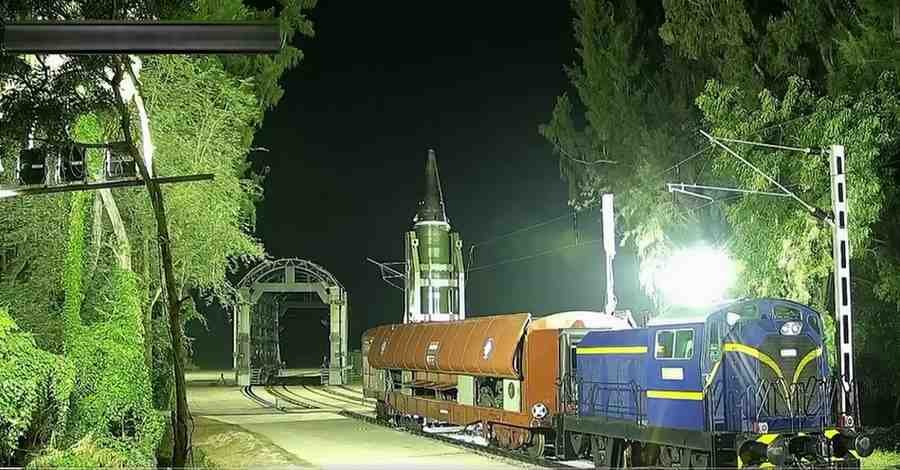India Demonstrates Next-Gen Missile Capability
India has taken a significant leap in its strategic deterrence program with the successful test-firing of the Agni-Prime (Agni-P) intermediate-range ballistic missile from a rail-based mobile launcher system. The launch, carried out on Thursday, marked the first time that such a canisterised missile was fired from a specially designed launcher mounted on the nation’s extensive rail network.
This innovation enhances India’s ability to ensure rapid deployment, cross-country mobility, and a much shorter reaction time during critical security scenarios.
Rajnath Singh Hails Breakthrough Achievement
Defence Minister Rajnath Singh congratulated the Defence Research and Development Organisation (DRDO), the Strategic Forces Command (SFC), and the Armed Forces for the historic milestone. He highlighted that the rail-based launch capability places India among a select group of nations that can deploy nuclear-capable missiles from mobile rail systems, significantly increasing operational flexibility.
“This successful flight test has placed India in an elite league of nations with advanced canisterised launch systems operational from the rail network,” Singh said in a statement.
Intermediate Range Agni-Prime Missile was successfully tested on 24 Sep 2025 from a Rail based Mobile launcher. This will be a force multiplier to strategic forces, with a game changer road cum rail missile system pic.twitter.com/bEmDQoHNUf
— DRDO (@DRDO_India) September 25, 2025
Technical Features of Agni-Prime
The Agni-Prime missile, part of the advanced Agni series, has a strike range of up to 2,000 kilometres. This range enables India to cover all of Pakistan and vast parts of China, reinforcing its strategic deterrence posture in the region.
Key features of the missile include:
-
Canisterised Launch System for quick deployment and storage.
-
Cross-country mobility through both road and rail networks.
-
Reduced visibility for enhanced survivability against enemy detection systems.
-
Independent launch capability, supported by cutting-edge communication systems.
-
Protective mechanisms to ensure operational reliability under diverse conditions.
The missile is fully self-sustained and capable of being launched without external logistical dependencies.
Test Launch Meets Mission Objectives
According to DRDO officials, the missile’s trajectory was precisely tracked by multiple ground stations, radar systems, and telemetry points. The launch was described as a “textbook flight”, successfully meeting all mission parameters and validating the missile’s performance.
Secretary of Defence R&D and DRDO Chairman congratulated all participating teams, noting that the success reflects India’s growing indigenous expertise in missile technology.
Part of India’s Strategic Arsenal
The Agni-P missile has already been inducted into service after a series of successful road-mobile tests. The addition of a rail-based launcher further strengthens the Strategic Forces Command’s ability to disperse, conceal, and rapidly launch missiles in response to threats.
This milestone follows the Agni-5 “Mission Divyastra” test in March 2024, which showcased India’s capability to deploy MIRV (Multiple Independently Targetable Re-entry Vehicles). A MIRV-equipped missile can carry three to four nuclear warheads, each directed at different targets, making it an advanced force multiplier.
Regional and Strategic Implications
With the Agni-P’s strike range, India ensures coverage of all adversarial territories within 2,000 kilometres, enhancing deterrence against both Pakistan and China. Defence experts note that the rail-based system provides added resilience to India’s nuclear doctrine of credible minimum deterrence and second-strike capability.
The system’s reduced visibility and rapid mobility make it more difficult for adversaries to track or neutralize launch assets, giving India a strategic edge in terms of survivability and response.
Looking Ahead
India’s successful test underscores the country’s commitment to self-reliance in defence technology and its evolving nuclear deterrence strategy. The Agni series, already regarded as the backbone of India’s missile arsenal, continues to evolve with the incorporation of next-generation mobility, precision, and survivability features.
With the Agni-Prime now tested successfully from both road and rail systems, the nation’s strategic forces are better prepared to counter regional threats while maintaining stability through deterrence.








